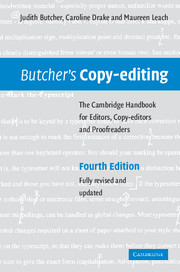Book contents
- Frontmatter
- Contents
- List of illustrations
- Preface to the fourth edition
- Preface to the third edition
- Preface to the second edition
- Preface to the first edition
- Acknowledgements
- 1 Introduction
- 2 Preliminary copy-editing, design and specimen pages
- 3 Preparing the text for the typesetter
- 4 Illustrations
- 5 Proofs
- 6 House style
- 7 Preliminary pages
- 8 Indexes
- 9 Other parts of a book
- 10 Bibliographical references
- 11 Literary material
- 12 Multi-author and multi-volume works
- 13 Science and mathematics books
- 14 Other special subjects
- 15 Reprints and new editions
- 16 On-screen editing
- Appendixes
- Glossary
- Select bibliography and other resources
- Index
6 - House style
Published online by Cambridge University Press: 05 August 2012
- Frontmatter
- Contents
- List of illustrations
- Preface to the fourth edition
- Preface to the third edition
- Preface to the second edition
- Preface to the first edition
- Acknowledgements
- 1 Introduction
- 2 Preliminary copy-editing, design and specimen pages
- 3 Preparing the text for the typesetter
- 4 Illustrations
- 5 Proofs
- 6 House style
- 7 Preliminary pages
- 8 Indexes
- 9 Other parts of a book
- 10 Bibliographical references
- 11 Literary material
- 12 Multi-author and multi-volume works
- 13 Science and mathematics books
- 14 Other special subjects
- 15 Reprints and new editions
- 16 On-screen editing
- Appendixes
- Glossary
- Select bibliography and other resources
- Index
Summary
Some publishers have a fairly rigid house style covering spelling, abbreviations, etc.; others follow the author's own style in most things, if it is sensible and consistent. Each procedure has its advantages and disadvantages. If you are to follow the author's style you cannot always start the detailed marking straight away: you first need to discover what the style is, which may be difficult if the author is not entirely consistent or if the system is unconventional; and you then need to evaluate the system. However, a rigid house style may mean altering a perfectly good system; and the more changes you make the more likely you are to miss some instances and to present authors with an inconsistent version of a system they did not choose. It is obviously best to brief authors before they prepare their final text, to tell them about the publisher's preferences, and to ask them above all to be consistent.
Even if your publisher has a house style, it will not cover every spelling, hyphen and capital. So keep a note of the author's system as you go through the typescript, noting the folio number of each occurrence or making a marginal mark, until you have decided what the style should be. Some of these style points may be incorporated in a style sheet for the typesetter and proofreader.
- Type
- Chapter
- Information
- Butcher's Copy-editingThe Cambridge Handbook for Editors, Copy-editors and Proofreaders, pp. 117 - 166Publisher: Cambridge University PressPrint publication year: 2006



